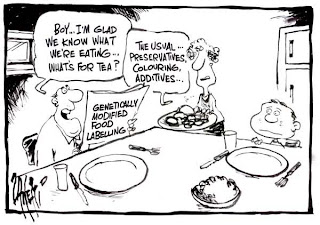I have heard about genetically modified food science, I have listened to the news stories, but I must admit I haven't truly done my research and consider myself fairly ignorant of what it really is about. There was a lot of scientific jargon, and I had to pull out my college biology and chemistry books for some refreshers, but here is what I have learned:
- All living things have genes located inside our chromosomes (actually remember this from biology class, score!)
- Genetically modified foods are also know as; transgenic crops, genetically engineered crops
- Particle bombardment - use a gene gun (yes that is a real thing) to bombard the cell with small particles
- Only the new cells the scientists have created survive once they encounter an antibiotic or herbicide
- The U.S. Government does NOT require farmers to check the levels of toxic natural chemicals in their crop, the farmers monitor that on their own accord
Those are just a couple things. I know cross breeding has been going on for decades. Heck we cross-breed dogs all the time (Cockapoo anyone?) Some scientists claim that this genetic alteration is just a more precise way of doing what farmers have been doing forever. (Also interesting to note here that with what I read on plants, they are examined to make sure the implanted gene ONLY affects the area it needs to blend with and nothing else). The much fancier word for all of this is, Recombinant DNA technology, or rDNA tech.
While thinking about mutating our crops and animals seems very X-Men (X-Manimal?) of our scientists, the face that the world demand of food is supposed to double by 2050 (WFO), one has to wonder how we can feed the world without letting science get involved. If we are so concerned about it (which I will admit I definitely am) why can't we just label the food and let people choose for themselves? Actually, that is a proposed law for the California ballot, to label all food that has been GMO'd. There is even a song for all the propositions in California, take a look if you want:
In the United States, we have seen a sharp rise in allergies, asthma, ADD and Autism, among other things. Europe has not seen nearly as much, and the European Union is very strict on what kind of imported foods they accept. According to the European Food Safety Authority, there are no GM animals or products on the EU market (another article read that anything that is .9% or higher GMO'd is not accepted). It does make one wonder. European friends of mine have even noted about all the boxed food we have, whereas, when I have been in Europe, there are fruit stands, butchers and bakeries everywhere - yes, even in downtown big cities like Paris. They eat so much more fresh food than we do, but the EU also seems to make a much better point of making it visible and available.
Having been invited by Winger's Roadhouse Grill to see how fantabulous their new menu is, I had to ask about the chicken they serve at their restaurants. This is what I was told by the man who goes to the farms and checks on the things himself:
We work with chicken companies that are humane in their treatment of their birds (no force feeding) and we do not allow any growth hormone or steroid use. Therefore we accept that there will be some variance. If our specifications EVER drop below the variance allowed, we refuse product back to the producer.
Good to know! He also claimed that most restaurants like ours do not use GM chicken as well. He noted that people had complained about size; sometimes they were ginormous sometimes small, I asked him to explain.
We buy the largest wings available on the market today and that is called a 6-8 count wing. There are not very many of this size available and as a result we buy a large percentage of what is produced country wide. It is true, however, that in late summer and early fall, birds are at their smallest and the wings produced are on the smallest side of the variable size. This is due to chickens summer diet and their lack of appetite.
I could go on and on about this (really, I did a lot of research, it's really fascinating), but I do not want to drone on forever and potentially bore you all. I have provided the links below to the websites I used to get my information. Feel free to read more if you like. For me, I want my food to be as natural as possible. I guess that makes sense when I love being in the kitchen making everything I can from scratch. So whether you're for GMO or you're GM-No! just be sure you are eating healthy foods with lots of flavor! A little butter and sugar never hurt either.
Sources:
http://www.nyu.edu/classes/jaeger/genetically_modified_foods.htm
http://www.nepadbiosafety.net/subjects/biotechnology/process-of-developing-genetically-modified-gm-crops
http://www.latimes.com/news/science/la-sci-gmo-crop-breeding-methods-20121025,0,3301041.story
http://www.csa.com/discoveryguides/gmfood/overview.php
http://ballotpedia.org/wiki/index.php/California_Proposition_37,_Mandatory_Labeling_of_Genetically_Engineered_Food_(2012)
http://www.ornl.gov/sci/techresources/Human_Genome/elsi/gmfood.shtml
http://www.efsa.europa.eu/en/topics/topic/gmanimals.htm
http://www.gmo-free-regions.org/gmo-free-regions/gmo-free-retailers.html

